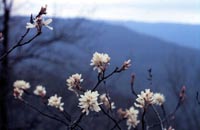Resource Library
Plant of the Week: Shadbush (Service Berry, Juneberry, Sarvis)
The University of Arkansas System Division of Agriculture does not promote, support or recommend plants featured in "Plant of the Week." Please consult your local Extension office for plants suitable for your region.
Plant of the Week
Sarvis, Service Berry, Juneberry, Shadbush
Latin: Amelanchier arborea

As gardeners we know when spring arrives. We mark the arrival of spring by the blooming
of daffodils, forsythia, Bradford pear and saucer magnolia. All of these plants are
visitors to our gardens from Europe and Asia. Are these foreigners to be trusted to
decide when winter has passed away and another gardening season commenced?
Over my 26 years in the Ozarks I have logged blooming dates -- all be it on an on
and off basis -- of some of the common landscape plants. The arrival of spring this
year in northwest Arkansas is two to three weeks earlier than normal, with surprisingly
little difference in bloom date between the northern part of the state and the central
part of the state, which usually blooms about 10 to 14 days before the north. This
year there is maybe a three to four day difference. These bloom dates are based on
the landscape plants mentioned above, but one of our natives, the sarvis, is not so
sure spring has arrived.
Sarvis is a 25-foot tall deciduous tree that produces an abundance of five-petaled
white blooms in terminal clusters. It occurs as a scattered tree in the woods as an
understory plant, often in higher, better drained sites than where dogwood or redbud
would grow. Over my years of observation I have found sarvis to be one of the most
erratic plants with regard to bloom date, but one of the most reliable predictors
of the arrival of spring. And so far this year, sarvis is yet to bloom.
Spring blooming woody plants develop flower buds in the fall, but these flowers are
dormant and must undergo chilling to break dormancy. Orchardists, primarily working
with apples and peaches, have developed models to determine when particular fruit
cultivars will bloom based on the concept of accumulation of "chill hours." The optimum
temperature for accumulating chill hours to break flower bud dormancy lies between
35 degrees and 45 degrees. When the temperature falls below freezing or above 55 degrees,
no chill hours are accumulated.
For temperatures that are less than optimum but below 55 degrees and above freezing,
hours accumulate at half the rate of the optimum range. Once the chill hours have
been accumulated, blooming will commence provided the weather is warm enough for flower
buds to grow.
Forsythia requires about 800 hours of chilling to break flower bud dormancy while
Bradford pear requires about 900 hours. Sarvis requires about 1,000 chill hours, and
if it has received that amount of chilling, blooms appear very quickly. But if it
hasn’t had enough chilling it will still flower but the flowers are slow to appear.
In the typical winters of two decades ago, sarvis was the first to bloom, often appearing
in late February or early March. It seemed to miss late spring freezes every year.
In the past three winters it has been blooming in late March and still is missing
the late spring freezes. So, if you are impatient to plant the tomatoes, you best
believe the lesson taught by sarvis, and delay another week or two.
Sarvis is an excellent landscape tree suitable for locations where a small specimen
tree is needed. It will bloom in some shade, so is a good choice for those with tree-covered
lots. Once established, plants have good drought tolerance. Plants are available from
the state’s traditional nurseries that carry a diverse line of trees, but are not
common in the mass market garden center stores. They are not susceptible to any serious
insect or disease pests, but poor drainage can cause plant loss.
By: Gerald Klingaman, retired
Extension Horticulturist - Ornamentals
Extension News - March 14, 2000
The University of Arkansas System Division of Agriculture does not maintain lists of retail outlets where these plants can be purchased. Please check your local nursery or other retail outlets to ask about the availability of these plants for your growing area.